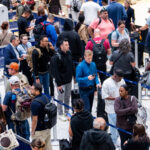Hundreds of older Boeing Co. 737 NG aircraft around the world may have to be urgently inspected in coming days after the discovery of cracks in a part of the plane that holds the wings to the fuselage.
The cracks were discovered in three 737-800s being converted from passenger planes to cargo aircraft, the U.S. Federal Aviation Administration said in a notice to international operators viewed by Bloomberg. Each of the planes had been used for more than 35,000 flights, the FAA notice said.
Boeing has determined that its existing inspection routines for the planes aren’t adequate to find the cracking, so the company is developing new routines to ensure the issue doesn’t threaten flight safety, according to the notice. The company is also working on repair instructions and producing spare parts.
“Boeing has notified the FAA and been in contact with 737 NG operators about a cracking issue discovered on a small number of airplanes undergoing modifications,” the company said. “No in-service issues have been reported.”
The cracking is considered an urgent issue and, under the expected FAA order, older planes will have to be inspected within a week, said a person who wasn’t authorized to discuss the matter and asked not to be named. The agency directive is due to be issued within days.
The 737 NG, or Next Generation, aircraft include the 737-600, 737-700, 737-800 and 737-900.
The plane’s latest version, known as the 737 Max, isn’t affected. The more efficient Max aircraft are grounded worldwide following a pair of fatal crashes in Indonesia and Ethiopia.
Some airlines have already begun performing inspections. Southwest Airlines Co. Chief Executive Officer Gary Kelly said Monday in a notice to employees that the carrier so far hasn’t discovered any cracks and is hopeful the issue won’t alter its flight schedule.
The part, known as a pickle fork because of its resemblance to the kitchen utensil, is part of the assembly that is used to attach the plane’s wings.
An FAA order only applies to U.S. carriers, but regulators in other nations typically follow the agency’s lead on such issues.
–With assistance from Julie Johnsson and Mary Schlangenstein.
Was this article valuable?
Here are more articles you may enjoy.

 Weather Claims and Bad Faith in the Face of Climate Change
Weather Claims and Bad Faith in the Face of Climate Change  US Airlines Cut Flights, With More Cancellations into Next Week
US Airlines Cut Flights, With More Cancellations into Next Week  JPMorgan Analyst Sues Over Pay Gap With Male Colleague in UK
JPMorgan Analyst Sues Over Pay Gap With Male Colleague in UK  Tesla Sued Over Claim Faulty Doors Led to Deaths in Fiery Crash
Tesla Sued Over Claim Faulty Doors Led to Deaths in Fiery Crash 